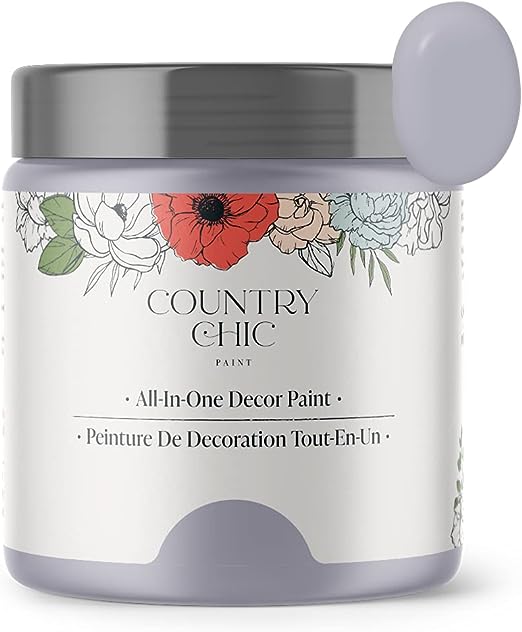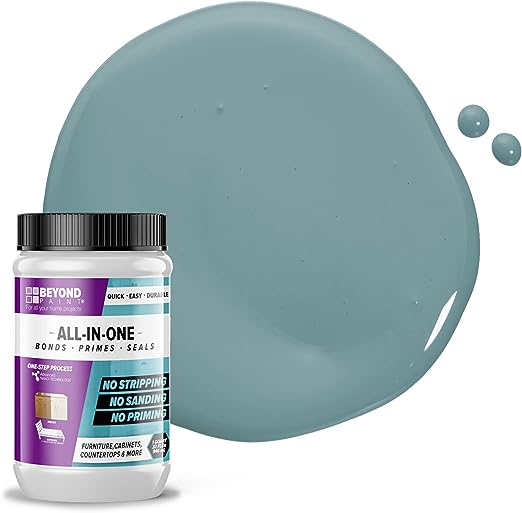Reviving your kitchen cabinets with a fresh coat of paint can breathe new life into your space and completely transform its look. However, the task isn’t as simple as choosing any paint and applying it. The choice of paint plays a pivotal role, especially considering the heavy workload that kitchen cabinets endure daily.
Chalk paint and Cabinet paint are two contenders at the forefront of the painting world when it comes to kitchen cabinetry. Each offers distinct advantages, but making the right decision requires a thorough understanding of their characteristics and capabilities.
In this blog, I’ll break down the key differences between Chalk Paint and Cabinet Paint, helping you make an informed decision for your next painting project.
Chalk Paint vs Cabinet Paint: Their Differences Explained
1. Finish and appearance
Chalk paint is renowned for its matte, chalky finish. This gives a rustic and vintage vibe to your cabinets. It’s perfect for achieving that shabby chic or farmhouse look that has gained so much popularity. The paint’s chalky appearance also lends itself well to distressed finishes, where you purposefully wear away the paint in certain areas to create an aged effect. This makes chalk paint an excellent choice for DIY enthusiasts who enjoy experimenting with different textures and finishes.
On the other hand, cabinet paint offers a smoother and more professional finish. It provides a polished and refined appearance that works well in modern and contemporary settings. Cabinet paint typically dries to a hard, durable finish that can withstand the rigors of everyday use. Its clean and elegant look makes it an ideal choice for kitchens, bathrooms, and other high-traffic areas where cabinets need to maintain their pristine appearance.
2. Application and ease of use
One of the standout features of chalk paint is its user-friendly application process. Chalk paint adheres well to most surfaces, often eliminating the need for extensive priming or sanding. Its forgiving nature allows for a bit of imperfection, making it a great option for beginners or those looking for a hassle-free painting experience.
Cabinet paint usually requires a more meticulous preparation process. To achieve that smooth finish, sanding and priming are often recommended. While this may add a bit more effort to the project, the end result is a professional look that can stand up to daily wear and tear.
3. Durability and longevity
While chalk paint offers a unique aesthetic, its durability might not be as robust as that of cabinet paint. The matte finish can be more susceptible to chipping and wear over time, especially in high-traffic areas like kitchens.
Cabinet paint is specifically formulated to withstand the demands of frequent use. It’s designed to create a hard, durable surface that can handle daily cleaning, moisture exposure, and even the occasional bump or scrape. This makes it an excellent choice for cabinets in functional spaces like kitchens and bathrooms, where longevity is a top priority.
4. Color options
Chalk paint comes in a wide range of colors, catering to various design preferences. Its muted and chalky finish can enhance the charm of vintage-inspired color palettes. It’s also popular for achieving pastel and distressed looks, adding character to furniture pieces.
Cabinet paint offers an extensive array of colors as well. From classic neutrals to vibrant shades, you can find the perfect hue to complement your overall kitchen or bathroom design. The smooth finish of cabinet paint showcases the true color without altering its appearance.
5. Price
When considering the price of chalk paint, it’s important to factor in both the initial cost of the paint itself and any additional products that might be needed. Chalk paint tends to be relatively higher in price compared to standard latex paints.
Cabinet paint often falls within the range of standard latex paints, making it a cost-effective choice. While the initial price might be lower than that of chalk paint, it’s essential to consider the overall value.
Advantage and Disadvantage of Chalk Paint

Here are the advantages of chalk paint
- Ease of Use: Chalk paint is known for its user-friendly application process. It adheres well to various surfaces, often eliminating the need for extensive sanding or priming. This makes it an excellent choice for DIY enthusiasts and beginners who want to achieve professional-looking results without the hassle.
- Minimal Prep Work: Unlike traditional paints, chalk paint usually requires minimal preparation before application. In many cases, a quick cleaning of the surface is sufficient. This can save you time and effort compared to other types of paint that may demand more extensive prep work.
- Unique Finish: Chalk paint offers a distinct matte finish that imparts a vintage and rustic charm to furniture and decor. It’s a popular choice for achieving shabby chic, farmhouse, and distressed aesthetics, adding character and personality to your pieces.
- Distressing Capabilities: Chalk paint is particularly well-suited for distressing techniques. If you desire an aged or weathered look, you can easily sand away sections of the paint to reveal the underlying layers, creating an authentic vintage appearance.
- Quick Drying Time: Chalk paint generally dries relatively quickly, allowing you to move on to subsequent layers or finishing steps sooner than with some other paints.
Here are the disadvantages of chalk paint
- While chalk paint offers a unique aesthetic, it might not be as durable as other paint types. The matte finish can be more prone to chipping and wear, especially in high-traffic areas. To enhance durability, applying a sealing topcoat or wax is often necessary.
- While chalk paint comes in a variety of colors, the range may be more limited compared to other types of paint. If you’re looking for a specific and diverse color palette, you might find your options somewhat constrained.
- Chalk paint is generally more expensive than standard latex paints. While it can provide good coverage, you may need to use more paint to achieve a solid finish, particularly if you’re working with a dark base color.
- The matte texture of chalk paint might not be suitable for every project. Some surfaces, such as cabinets or areas with high moisture exposure, might benefit more from a smoother and more durable finish offered by other paint types.
- Achieving the desired look with chalk paint often involves extra steps. Distressing, waxing, or sealing are typically needed to complete the finish, adding to the overall time and effort required for the project.
Advantage and Disadvantage of Cabinet Paint

Here are the advantages of cabinet paint
- One of the primary advantages of cabinet paint is its exceptional durability. Cabinet paint is designed to withstand the wear and tear that cabinets experience, making it a perfect choice for high-traffic areas like kitchens and bathrooms. It forms a hard, durable surface that can resist scratches, stains, and moisture.
- Cabinet paint provides a smooth and polished finish that lends a professional and elegant look to cabinets. This sleek appearance works well in modern and contemporary design schemes, contributing to a sophisticated overall aesthetic.
- Cabinet paint comes in a wide range of colors, allowing you to find the perfect shade to match your design vision. From classic neutrals to vibrant hues, you can choose the color that complements your space.
- Due to its durability and resistance to everyday wear, cabinet paint can prolong the life of your cabinets without requiring frequent touch-ups or repainting. This longevity can save you time, effort, and money in the long run.
- Cabinets in kitchens and bathrooms are often exposed to moisture and humidity. Cabinet paint is formulated to resist these conditions, preventing warping, peeling, or other water-related damage.
Here are the disadvantages of cabinet paint
- Applying cabinet paint usually involves more extensive preparation compared to some other types of paint. Proper sanding and priming are essential to achieve the desired smooth and even finish. This extra step can extend the timeline of your project.
- Cabinet paint often has a longer drying time compared to certain other paints. This means you’ll need to wait longer between coats and before you can handle the painted surfaces.
- Achieving a flawless finish with cabinet paint might require more skill and attention to detail. The smoother finish can highlight imperfections, making precision in application crucial.
- While not as expensive as some specialized paints, cabinet paint is generally pricier than standard latex paints. However, considering its durability and long-lasting qualities, it can be a cost-effective choice in the long run.
- Cabinet paint is not as conducive to distressed or vintage finishes as chalk paint. If you’re seeking a more weathered look, cabinet paint might not offer as many options for achieving this effect.
Factors to Consider when Choosing Your Paint
In this section, I’ll be discussing about the key considerations that should guide your decision-making process. By taking these factors into account, you can make an informed choice that results in a successful and satisfying painting project.
1. Aesthetic preference
The appearance of your finished project matters, and your aesthetic preferences should be a driving force in your paint selection. Consider the overall style you want to achieve whether it’s a rustic, vintage look, a sleek and modern finish, or something in between. Different paint types offer varying finishes, from matte to glossy, each contributing to the desired visual impact. Your chosen paint should align with your vision, enhancing the beauty and character of your space.
2. Budget
Budget is a practical consideration that plays a significant role in your paint choice. While some paints may have a higher initial cost, they might offer long-term savings due to factors like durability and coverage. Assess your budget for the entire project, including not only the paint itself but also any necessary additional materials, such as primers and sealants. Strike a balance between cost and quality to ensure you’re getting the best value for your investment.
3. Longevity
The longevity of your paint finish directly influences how often you’ll need to touch up or repaint your project in the future. Consider the wear and tear the painted surface will face, especially in high-traffic areas like kitchens and bathrooms. Some paints are formulated for durability, with features that resist chipping, fading, and moisture damage. Choosing a paint that can withstand daily use can save you time, money, and effort in the long run.
4. Project scale
The size and scope of your project should also guide your paint decision. Larger projects may require more paint, affecting your budget and potentially influencing the type of paint you choose. Additionally, the complexity of the project and the surface you’re painting can impact the application process. If you’re tackling a substantial project, it’s essential to choose a paint that balances ease of application with the desired finish.
Conclusion
In the world of furniture and cabinetry refinishing, the choice between chalk paint and cabinet paint is far from a simple decision. Both options offer unique advantages and drawbacks that cater to various project needs and personal preferences. As we’ve explored throughout this guide, each type of paint has its own set of characteristics that can either enhance or limit your desired outcome.
This article will make you make an informed decision on making the right choice between Chalk Paint and Cabinet Paint.
